Menu
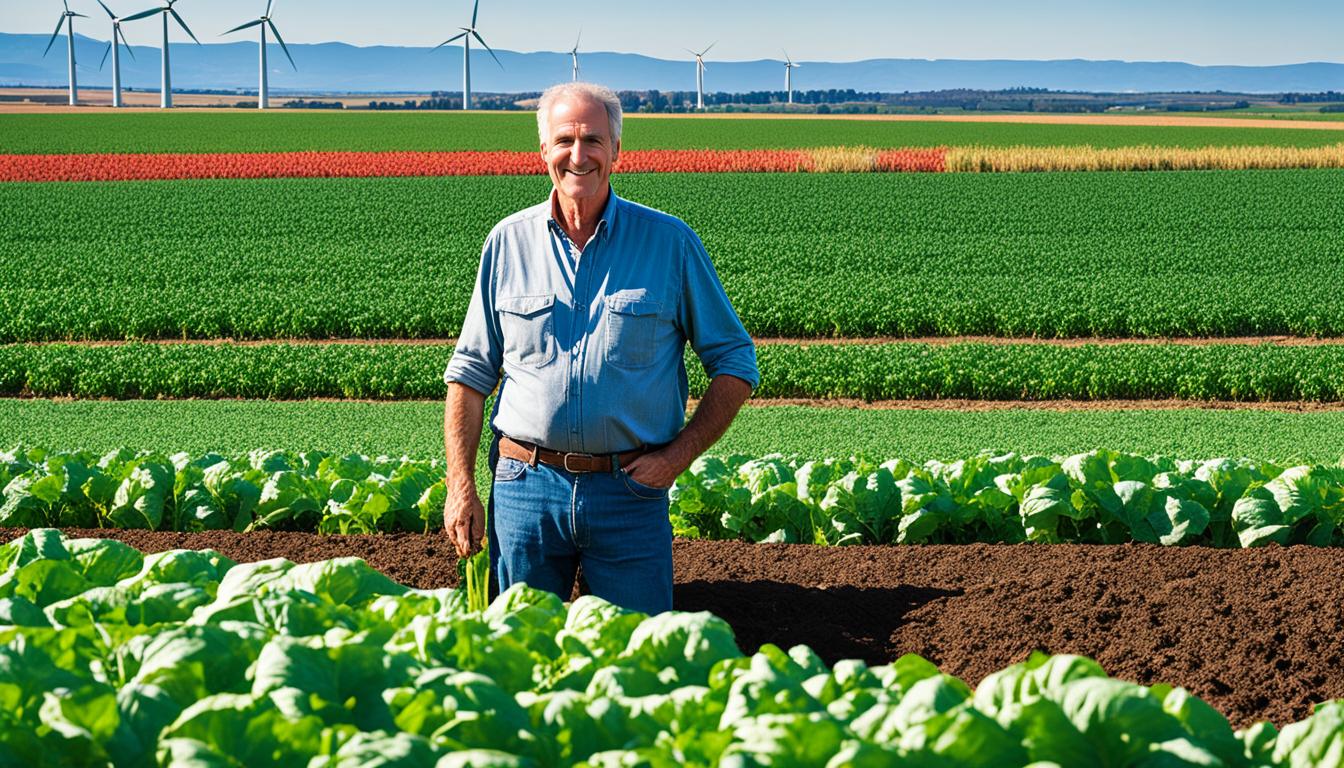
Did you know that farming takes up 70% of the world’s fresh water? This shows the huge role we play in future farming. We can make soil and land better, use less water, and cut environmental harm with green farming. Places like Ecowood Habitat show we can live well with nature. By choosing sustainable farming, we save our planet and keep our farms working for a long time.
Sustainable farming is all about farming in ways that keep our planet healthy. It balances the need for food with environmental protection. With the population set to jump by 2 billion in the next 30 years, we must farm smarter.
We need to find new ways to grow food that don’t harm the Earth. Sustainable farming uses the best of traditional and modern farming. This way, we can feed everyone without making our planet suffer.
Sustainable farming means farming in ways that make good use of resources. It keeps the ecosystems safe and the soil healthy. Various methods like changing what crops grow each year and using water more efficiently help. These methods ensure we can keep farming well into the future.
As more people need food, we must farm in ways that don’t harm the Earth. For example, Mexico’s “MasAgro” and the “System of Rice Intensification (SRI)” increase food production without damaging the environment. Sustainable farming also helps us tackle big issues like poverty and climate change.
It ensures we can keep growing food for everyone while protecting our planet. This is crucial for our future.
| Challenge | Statistics | Impact |
|---|---|---|
| Growing Population | 2 billion more people by 2050 | Increased demand for food and resources |
| Food Consumption | 60% more food needed | Equivalent to all food produced in the last 500 years |
| Water Scarcity | 50% more freshwater required annually | Optimising water use through innovative techniques |
| Environmental Goals | 17 Global Goals commitment | Addressing poverty, injustice, and climate change |
Soil health and conservation are key to lasting farming. They use methods like crop rotation and cover cropping. They also cut down on tillage to keep soil rich and strong. A large part of the world’s farm soils are becoming less productive. This could hurt the food we all need to eat.
By farming sustainably, we help the soil stay healthy. This is important for the future. Good soil keeps more water, reduces erosion, and supports a healthy environment.
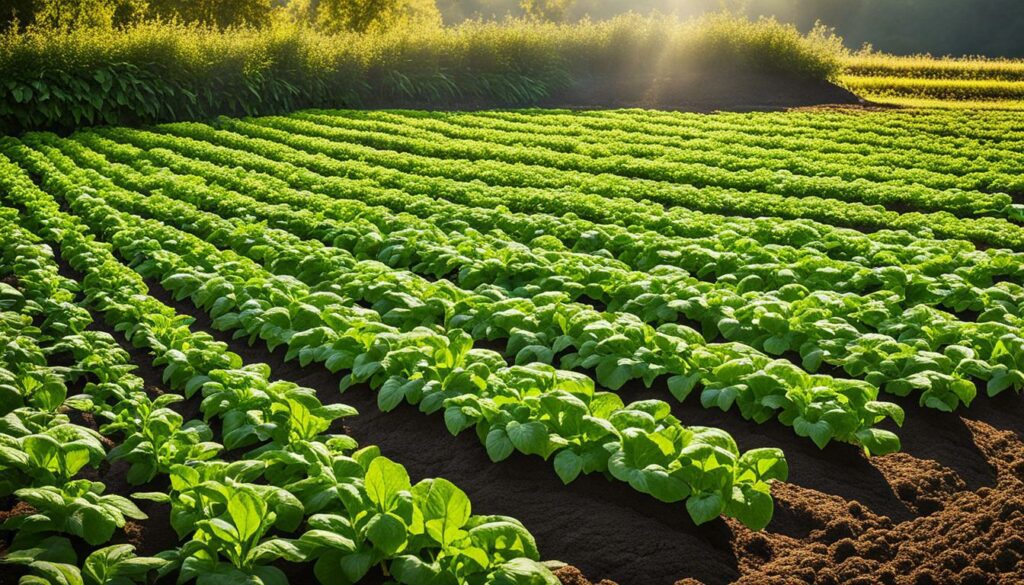
Switching crops is vital for the Earth’s health. This means growing different types of crops on the same land every year. It boosts the use of nutrients and reduces pest problems. Plus, it keeps the soil rich in major nutrients needed for big harvests. Mixing up crops also means farmers don’t rely on just one for their income. This helps if one crop fails.
Cover cropping is key for a healthy Earth. Farmers plant crops not to eat, but to protect the soil. These crops, like legumes and grasses, help the soil in many ways. They lock in nitrogen, add to the soil, and make it stronger. This stops soil from washing away too fast and helps water soak in better.
Disturbing the soil less is better for the planet now. Traditional ploughing is giving way to gentler approaches. This keeps more nutrients and structure in the soil. It also saves money by reducing soil erosion and running of nutrients.
These methods also trap carbon in the soil. This is good for fighting climate change. Using less energy on the farm is another perk. So, farming smarter is a win for the planet and farmers.
Choosing smarter ways to farm means the ground is kept healthy. This means keeping it covered, full of different plants, and not digging it up too much. These choices help keep farming possible for the long haul. They also protect our food supply.
| Benefits | Techniques | Impact on Soil Health |
|---|---|---|
| Improved Nutrient Management | Crop Rotation | Prevents nutrient depletion, improves soil fertility |
| Erosion Control | Cover Cropping | Reduces soil erosion, retains soil structure |
| Reduced Soil Disturbance | Minimal Tillage | Maintains organic matter, supports carbon retention |
Water management in agriculture is crucial. It uses more than half of our freshwater. This makes it the most water-needy sector. With agricultural needs set to increase by 70% by 2050, we must focus on sustainable water use.
Drip irrigation systems direct water to the roots of plants. They use just enough water. This method is more efficient than traditional ways. It can conserve up to 80% more water. Thus, it’s a smart choice for today’s farming.
Rainwater harvesting collects water for dry seasons. This reduces the need for other water sources. It has been successful in places like Australia. Including it in water management in agriculture helps farmers have water all year.
Planting crops that need less water can help a lot. It reduces the need for a lot of irrigation. This eases the strain on our water supplies. Combined with modern farming methods, like EOSDA Crop Monitoring, we can use water better.
This technology uses weather data to help farmers. It guides them in selecting crops and planning irrigation. This approach supports long-term sustainability.
| Practice | Water Conservation (%) | Benefits |
|---|---|---|
| Drip Irrigation | 80 | Reduces water wastage, doubles yield, precise water delivery |
| Rainwater Harvesting | Varies | Ensures water availability in dry periods, reduces reliance on other sources |
| Water-Efficient Crops | Significant | Reduces irrigation demand, adaptable to low-water conditions, optimises resource use |
Biodiversity is crucial for sustainable farming. It boosts ecosystem stability. It’s key to use various organic methods that enhance life on farms.
Crop rotation and companion planting help a lot. They make agriculture more diverse and balanced. This leads to a healthier ecosystem that’s also more productive.
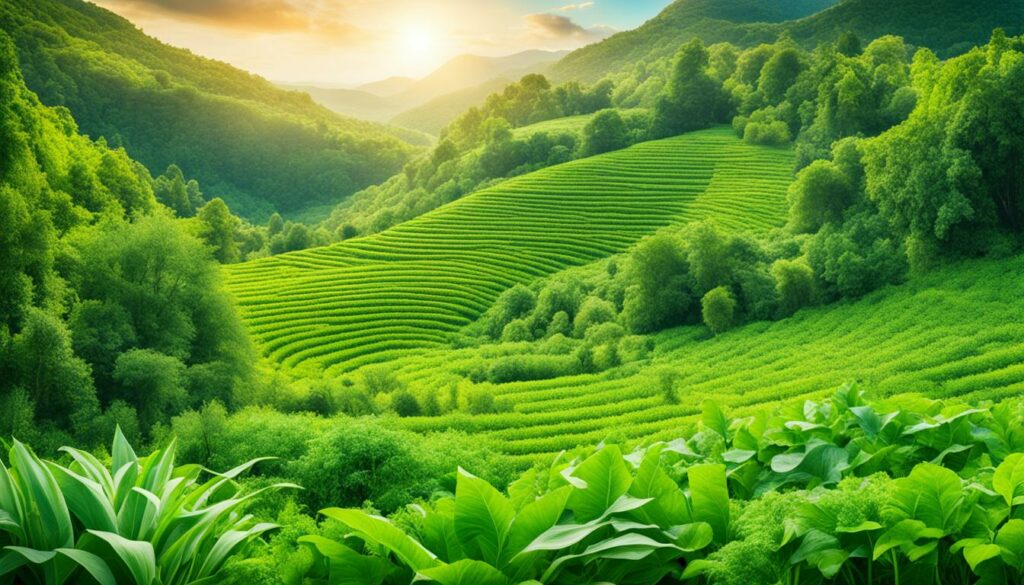
Ecowood Habitat is a great model for this. They mix many plants and animals in their farming. This boosts the ecosystem and helps control pests naturally.
They also focus on keeping the soil healthy. Cover crops and adding organic matter are their secrets. These keep the soil good for the long term.
Managing water well is vital too. Drip irrigation, precise farming, and collecting rainwater are big helps. They make water use better, which is key for supporting many kinds of farming.
By caring for biodiversity, farms become stronger. They rely more on natural balance. This helps farms stay productive for a long time.
| Method | Purpose | Benefit |
|---|---|---|
| Crop Rotation | Prevent soil depletion | Enhances nutrient cycling and pest control |
| Companion Planting | Support plant growth | Promotes biodiversity and natural pest management |
| Cover Cropping | Maintain soil health | Improves soil structure and fertility |
| Drip Irrigation | Precise water delivery | Conserves water, improves plant health |
| Rainwater Harvesting | Store water | Ensures water availability during dry periods |
Employing these organic methods boosts biodiversity. It builds the basis for a lasting farming system. These approaches help keep ecosystems healthy and productive for the future.
Organic farming is at the heart of sustainable agriculture. It makes use of natural resources to keep the soil rich and in balance. It helps the environment and human health too. Choosing organic is key for a healthy, long-lasting planet.
Organic farming avoids using artificial pesticides. This method protects nature’s variety and stops harmful chemicals from building up in the earth. It leads to better crops and helps the good bugs and animals survive. That’s crucial for a natural and healthy agriculture.
Organic fertilisers are vital for boosting soil health. Things like compost and green manure add key nutrients to the earth without harm. They make soil stronger, help good bacteria grow, and add more organic matter. All this keeps the soil productive and strong over time.
In the end, organic farming stands for a new way of growing food. It relies on natural ways to fight pests and fertilise. This farming is good for the land and for the creatures that call it home. It’s our best bet for a future where agriculture and nature thrive together.
Regenerative agriculture is a game-changer, based on methods used by native peoples for ages. It aims to heal the earth by improving soil, lessening chemical use, and supporting plants and people. These practices have deep roots in looking after nature for future generations.
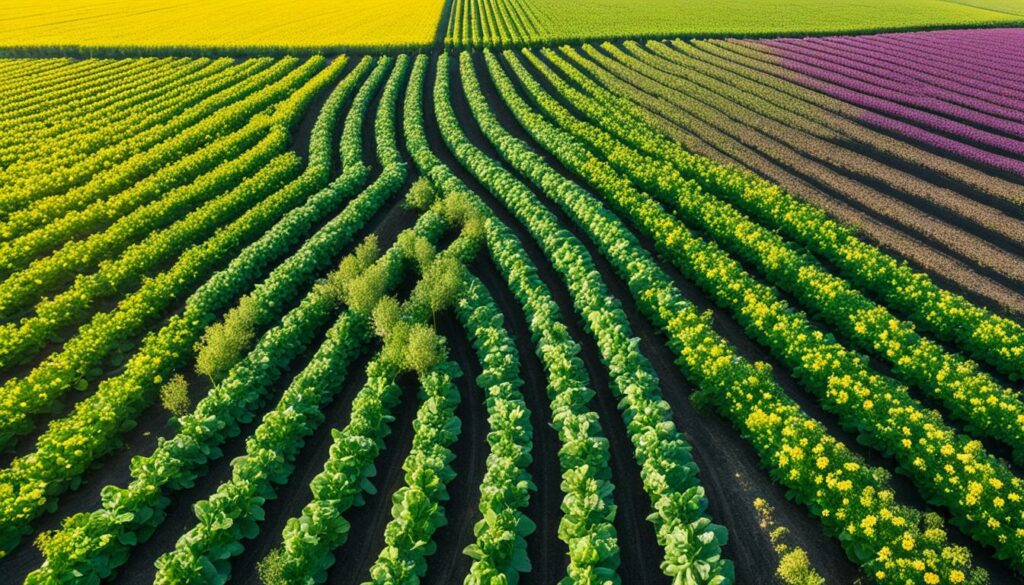
Cover cropping is vital in regenerative farming. Farmers plant these crops when they’re not growing main crops, helping the soil stay healthy. This simple act could help remove a huge amount of CO2, benefitting the environment. Cover cropping also helps keep water in the ground and stops valuable soil from washing away.
Minimal tillage does wonders for the soil. It involves doing less to disturb the earth’s surface. This keeps the soil in good shape, helps it keep more nutrients, and cuts down on soil being lost to wind or water. The World Resources Institute says growing food this way can add 4% more organic matter to the soil in a year. It also means water soaks into the ground better, cutting down on the need to water crops artificially.
Taking on methods like cover cropping and minimal tillage changes how we see farming. These approaches help nature, boost farm output, and last a long time. They are steps towards a future where farming sustains the land and the people who depend on it.
Using technology in sustainable agriculture is changing how farms are managed. Techniques like precision agriculture help farmers make the best use of resources. They reduce harm to the environment by using data to manage plant growth.
With more people to feed, the UN predicts we’ll need 70% more food by 2050. This is why we must farm sustainably. Vertical farming is one exciting way to do this. It grows crops upwards in stacks indoors, needing less land and water. The U.S. has more than 2000 of these farms, growing lettuce, herbs, and berries.
I’m excited about sustainable farming tech like precision agriculture. It uses tools like satellite images and sensors to manage crops better. Bee Vectoring Technologies are amazing too. They use bees to protect crops, avoiding harmful chemicals.
Regenerative ocean farming is also exciting. It involves growing shellfish and kelp under the sea. This not only creates food but helps our oceans too. Kelp, in particular, is rich in nutrients and good for the sea.
| Farming Method | Benefits |
|---|---|
| Vertical Farming | Produces higher yields and uses significantly less water |
| Precision Agriculture | Optimizes resources and increases profitability |
| Regenerative Ocean Farming | Helps mitigate climate effects and supports marine ecosystems |
| Bee Vectoring Technologies | Reduces the need for harmful chemicals |
Meeting global food needs and fighting hunger is vital, especially for the 10% of people who are starving. This is where sustainable tech in farming shines. It promises food security and a healthy planet for all.
The future of sustainable farming depends on mixing traditional methods with new technology. This is to meet the challenges of climate change and a growing world population. Farming makes up nearly a third of the world’s greenhouse gas emissions, the World Bank says. It’s crucial to switch to methods that are less harmful to the planet.
No-till farming and crop rotation are key. They keep carbon in the ground and reduce the need for chemicals. These methods keep soil healthy for the long term. They also help us grow food in ways that don’t harm the planet.
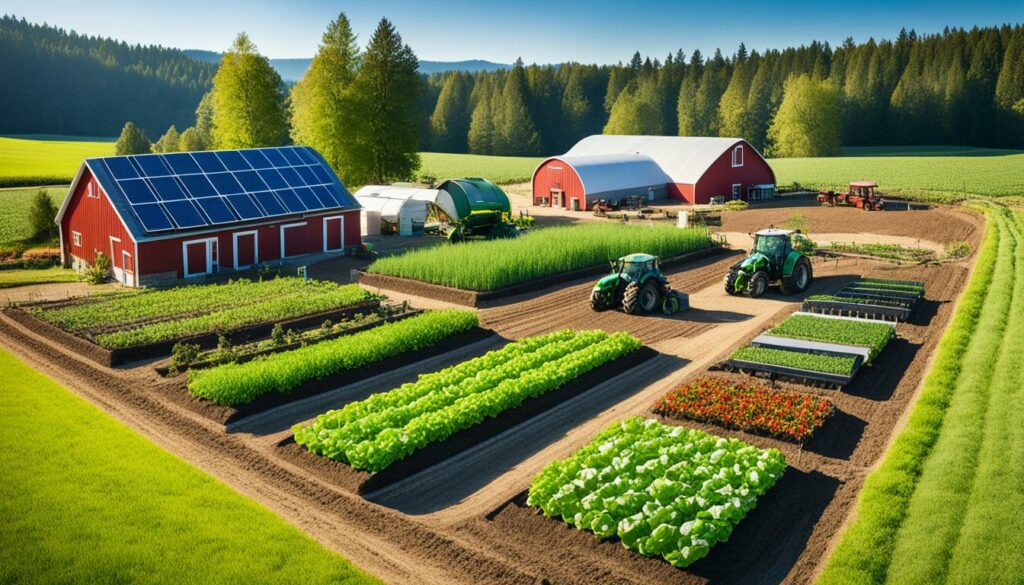
Technology is also changing how we farm. Now, we have AI that helps manage crops better, and biotechnology that makes plants stronger. Drones check on crops from the sky, and blockchain tracks food from farm to plate. These tools help us use resources more efficiently and reduce waste.
Money for farming and sustainability projects is important too. The National Institute of Food and Agriculture gives out loans and grants. The American Farm Bureau Federation spreads the word about how to farm in ways that help the environment. They focus on using smart methods and renewable energy.
Last year, 45 countries said they’d farm sustainably by 2030. The World Bank supports projects around the world that help farmers move food without causing too much harm. With the global population set to jump and climate issues worsening, we need to focus on sustainable ways of farming. This will help make sure there’s enough food for everyone while protecting our planet.
Reducing the food we waste is key in fighting climate change. Cutting food waste by almost a quarter by 2050 could stop a lot of harmful emissions, says the PRI Association. This is a big part of the solution.
Changing what we eat can also make a big difference. Foods made from plants, for example, cause much fewer emissions than those from animals. This shift could also leave a lot of land free for forests or other natural solutions. This would help make our planet stronger against climate change.
To sum up, the future of farming is bright. We’re combining the best of the old ways with new, green technology. These efforts are boosted by support from many countries and the private sector. By working together and using the best methods available, we can ensure a healthy future for farming.
Ensuring food security and sustainability is a big challenge. The world’s population keeps growing. We need to find ways to meet the increasing demand for food while protecting the planet. This means using smart farming, the latest technology, and wisely managing our resources.
As more people need food, our systems must adapt. Sustainable farming can boost food production by up to 75% more than traditional methods. It even raises crop yield by 30% more per acre. With organic farming improving crop quality by 20%, we get tastier and healthier food. By working together, we can make sure everyone has enough to eat, improving food security by 50%.
Cutting down on wasted food is key. A third of the food made worldwide never gets eaten. We need better ways to harvest, store, and share food to reduce this waste. Doing this not only fights hunger but is also a huge economic opportunity, worth over USD 400 billion. By not wasting food, we could feed an extra one billion people. For fish, where 20% of our protein comes from, efforts to waste less are crucial.
| Benefit | Percentage Increase |
|---|---|
| Crop yield per acre | 30% |
| Quality and taste of crops | 20% |
| Efficiency of food production | 75% |
| Food security levels within communities | 50% |
| Business opportunity by reducing food waste | $400 billion |
Ending food waste helps the planet and our economy. Using advanced food systems leads to a strong food supply for our future.
Climate change is challenging agriculture. It’s crucial for farmers to adopt practices that help their farms stay strong in changing conditions. These climate-resilient farming methods are key to keeping up with uncertain environmental changes.
Farmers pick crops that can handle various climates. They’re choosing crops that do well in harsh conditions like droughts and heatwaves. Because climate impacts, such as long droughts, are already affecting many people who rely on farming.
They’re also using new high-yield crop types, and planting crops in a specific order or together. These steps boost produce and keep the soil healthy. Thanks to crop breeding, there are new varieties that can cope with the changing climate better. This means less need for harmful pesticides and fertilisers.
Planting crops that don’t need a lot of water is a smart way to deal with climate change. These crops can survive with less water, which is perfect for areas that often go through droughts. The push for these crops is to make sure there’s enough food, especially when the weather gets tough.
Farmers are looking for weather updates to help them decide what to grow. The U.S. offers many plans and actions to aid farmers in choosing sustainable options. This support helps them bounce back faster from weather-driven setbacks.
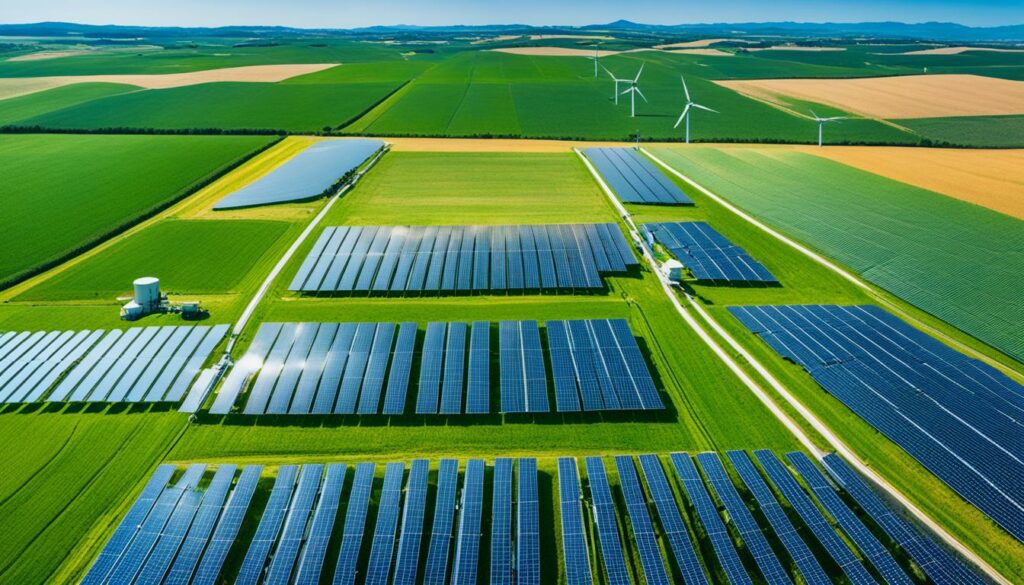
Many countries, including the U.S., EU, China, and India, are working on climate-smart farming. These efforts aim to improve food production, cut down on harmful emissions, and make rural communities more resilient. Using drought-resistant crops is a key part of this work, offering a lasting answer to climate challenges.
| Region | Climate-Resilient Practices | Initiatives and Support |
|---|---|---|
| United States | High-yield crop varieties, intercropping, drought-resistant crops | USDA programmes, local weather networks |
| European Union | NOMAD projects, sustainable agriculture development | EU funding for climate-smart practices |
| China | Climate-resilient crop breeding, minimal tillage | National initiatives for sustainable farming |
| India | Crop rotation, adoption of drought-resistant crops | Government support programmes |
To wrap up, using climate-resilient farming methods and focusing on drought-resistant crops are vital. They help secure the future of food production. These steps not only lessen climate change impacts but also empower farmers to succeed in a world with increasingly unpredictable weather.
Sustainable farming doesn’t just help the planet, it also makes good financial sense. It saves farmers money by using water, fertilisers, and pesticides wisely. This helps keep the land productive for future years.
Sustainable farming boosts how much food we make without harming the earth. This has been key in fighting poverty, making sure there’s enough food, and battling climate change for half a century. But, recently, we’ve seen a slowdown in the growth of making farming more efficient. This has meant we’re having to use more land to grow food.
A study in Colorado found that for every $1 spent on conserving land, over $6 were made for the local area.
Investing in farming that looks after the earth is also great for jobs. In the U.S., more than 450,000 people work in areas tied to organic farming, like making the food and selling it. The industry’s growth has been strong, with sales hitting around $55 billion in 2017.
Sustainable farming also opens up new job opportunities. Farms that welcome visitors and grow different crops create around 3.2 new jobs each. This way of farming is becoming more popular, with a 15% increase in unique crops being grown.
Building a future on sustainable farming keeps the countryside valuable. This helps towns and cities through more tax income. It’s a big deal because over a billion people worldwide depend on farming for their living.
Looking ahead, sustainable farming is set to keep growing. New ideas and more farmers using sustainable ways will make our food system stronger. This means a brighter economic future for farming.
| Statistic | Impact |
|---|---|
| Agricultural TFP growth reduced poverty | Increased food security, decreased land expansion |
| Organic industry annual sales growth (6% between 2014-2019) | Reached approximately $55 billion in U.S. sales in 2017 |
| 450,000 jobs supported by organic agriculture | Enhanced production, processing, retail, and manufacturing sectors |
| $1 in conservation practices | $6 for the local economy |
| On-farm diversification | Created 3.2 new full or part-time jobs per farm |
Sustainable farming isn’t just great for the environment. It’s also the key to a prosperous future for the economy and our children.
Moving to sustainable agriculture faces many hurdles. To succeed, challenges like sticking to old ways and limited budgets for small farmers must be tackled.
Switching from conventional to sustainable farming is tough but essential. The old ways, though productive, harm the environment and society. They involve using a lot of artificial chemicals. These chemicals hurt the land and cause pollution. Sustainable farming, on the other hand, uses a mix of organic and artificial fertilisers. This improves the soil and keeps the land diverse.
It’s key to teach farmers about the benefits of going green. Knowing about new, sustainable farming ways can change minds. Giving farmers advice tailored to their needs and ongoing help can smooth their switch.
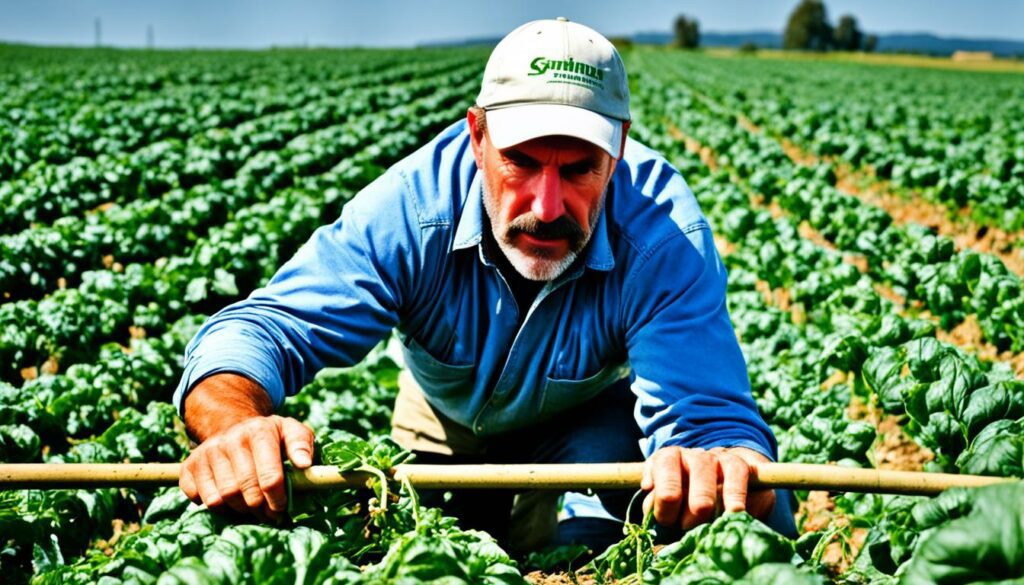
Money troubles are a big barrier in sustainable farming. This is especially true for small farmers in places like Sub-Saharan Africa. They depend on the weather for their crops. So, investing in green farming practices at first can seem too costly and hard.
But, embracing smart tech can make a big difference. For example, precision farming uses data to be more efficient. While starting this can be expensive, it pays off in the long run. It helps farmers make more money and farm smarter.
Also, support from the government and financial perks, like grants, can lessen the money burden. Making a market for green produce, where customers pay more for it, is another way to help farmers choose a sustainable path.
Many sustainable farming success stories and regenerative farming case studies show the benefits worldwide. These examples prove that farming in eco-friendly ways helps the planet and boosts farmers’ incomes.
Denmark excels in mixing livestock and crops sustainably. Farmers there enrich the soil by returning crop leftovers, which keeps the land healthy.
In California, farmers use cover crops to stop soil from washing away. They also practice precision farming. This combo saves resources and is reflected in many sustainable farming success stories.
In Ontario, Canada, community efforts shine through markets and collaborations. Locals join forces for sustainable growth. In Bali, the ‘Subak’ system shows how sharing water fairly supports lasting farming methods.
Kenya and Burkina Faso stand out with their regenerative farming case studies. In Kenya, agroforestry and rotating crops help the environment. Burkina Faso’s ‘Zaï’ method shows how creativity in using water can revive farmland.
Brazil leads in using agroecology to boost plant and animal variety. The project AgriMAX uses smart pest control, solar power, and drone technology for farming data. It sets a great example for others.
| Country | Practice |
|---|---|
| Denmark | Integrates livestock and crop production, returns crop residues |
| California | Cover crops for erosion prevention, precision farming |
| Ontario, Canada | Community-driven initiatives like farmers’ markets |
| Bali | Subak irrigation system |
| Kenya | Agroforestry and crop rotation |
| Burkina Faso | Zaï water management technique |
| Brazil | Agroecology to enhance biodiversity |
These sustainable farming success stories don’t just motivate; they also guide us on using green farming techniques in various areas. By applying these strategies, we can change farming landscapes for the better, take care of nature, and secure a bright future for all.
Agricultural education is key to sustainable farming. Courses and training in these methods give people the skills they need. AGRICOLLEGES International, for example, offers programs on regenerative, precision, and organic farming.
These programs explore the definition of sustainable agriculture. It’s about meeting people’s food and fibre needs without harming the environment. For example, Integrated Pest Management (IPM) uses tools to control pests safely for health and nature.
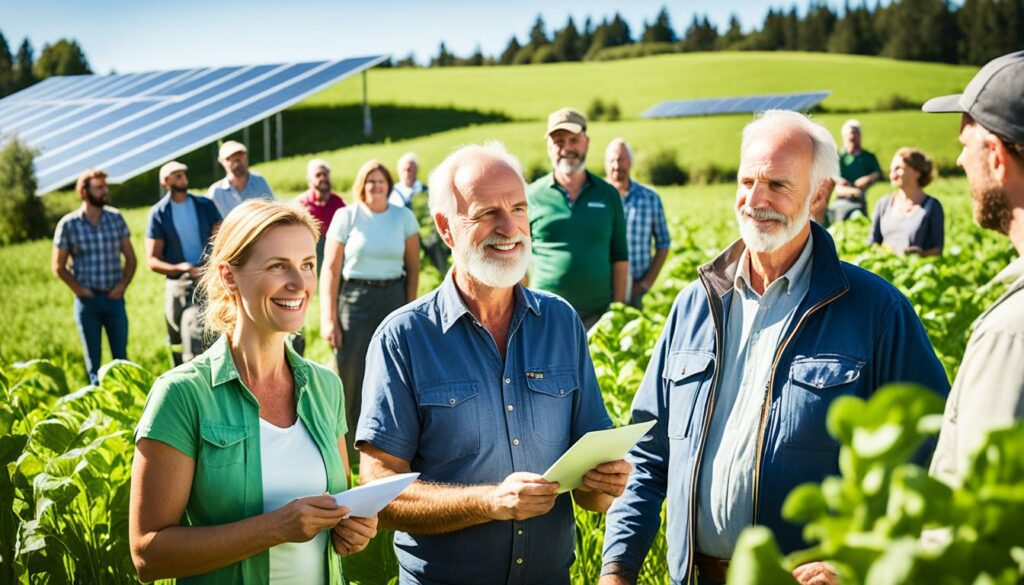
Management-intensive grazing systems include courses on rotational grazing. This teaches how to boost forage quality and cut feed costs. Methods like strip cropping and less tillage help keep soil in place, while water conservation practices improve water quality and supply.
Cover crops like rye are taught for weed control and improving soil health. Diverse crops and landscapes are highlighted to lower risks from bad weather or market changes. This also helps conserve soil and wildlife.
Learning proper nutrient management is a core part of these courses. This includes using manure to enrich soil and cut down on store-bought fertilizers. Agroforestry, which adds trees to farms, is also discussed for its benefits to crops and the environment.
The Sustainable Agriculture Research and Education (SARE) programme has been backing research for more than 30 years. It has helped farmers gain knowledge and improve their methods. SARE’s support has hugely helped in making agriculture more environmentally and economically sustainable.
Sustainable agricultural policies and government support for farming are crucial. They encourage eco-friendly practices. The government helps by offering subsidies, grants, and teaching. This way, farmers learn to farm in ways that are good for the planet. These efforts improve farming and keep our environment safe.
In places like Uganda, most public spending in agriculture goes towards fighting climate change. The spending aims to make the agricultural sector better at handling the changes. From 2010 to 2020, certain projects are expected to reduce carbon by a lot every year until 2030. This shows how important good policies are.
The government support for farming also drives the move to sustainable methods. In Europe, the Common Agricultural Policy (CAP) backs projects that are good for the environment. But this support is a global need. Places like China are also stepping up to protect the land through new policies and help.
It’s also very important to keep track of how well money is being spent in farming. The FAO has tools, like PERCC and EX-ACT, to check if the investments are working. With proper checks and balances, more countries can farm in ways that help fight climate change.
In the end, strong policies for sustainable farming and government support for farming create a solid foundation. This supports growing rural areas, encouraging new ideas, and making sure farming is possible in the future.
In today’s world, taking care of our planet is more important than ever. Sustainable farming offers hope for the future of food. It combines many methods like precision agriculture and agroforestry. These support the health of the land and meet our food needs. Sustainable farming is key to creating strong ecosystems and happy communities.
The numbers tell an important story. By 2050, we’ll have around 10 billion people to feed. This makes sustainable methods urgent. For instance, vertical farming is very efficient. It can grow as much food in one acre as 250 acres traditionally. This shows the huge benefits of using new technology in farming.
Reaching a sustainable future in agriculture needs everyone. Farmers, government, businesses, and local people must work together. This team effort is vital for food security and keeping the planet safe. Sustainable farming isn’t just a choice; it’s a vital step towards a future where we and nature live well together.
Sustainable farming keeps nature in balance while farming. It cares for the environment over a long time. This kind of farming is good for the land and future food.
It deals with big issues like too much heat, harming the land, not enough water, and losing plants and animals. It makes sure there’s enough food and that the earth is still good for those who come after us.
Good soil is at the heart of this kind of farming. Things like changing what you plant, keeping the ground covered, and not digging it up help. This keeps the soil rich, holds water, stops it blowing away, and keeps life in the soil.
These systems water plants just where they need it, using less water. They help grow more food without wasting water. It’s a smart way to use water on a farm.
Catching rain means having water when it’s dry. It helps use less water from other places and saves water. This is good for the land and for keeping farming sustainable.
Having many different living things helps the land stay strong and deals with pests naturally. For example, farms like Ecowood Habitat create a rich and living landscape. This way, they can keep farming well for the future.
Man-made pesticides can make the land and food sick over time. By not using them, organic farming keeps life in the soil and grows healthy food. It also doesn’t hurt the balance of nature.
Regenerative farming helps the ground and everything living in it to be well again. It uses ways that mean less soil washing away, more water stays, and some bad gases don’t go into the sky. This helps stop the earth from getting too hot.
New tech and smart ways of looking after the land are helping. By using things like maps, sensors, and machines that know where to go, less is wasted. These tools also look after nature better.
By being clever with what we plant and how we care for the land, more food can be made. Stopping waste and looking after what’s grown helps feed more people. This is how we can keep having enough food for everyone.
Farming in ways that don’t need too much water and can stand bad weather is key. These ways help the land deal with changes and still give food. It’s about being smart and ready for what nature throws at us.
Yes, there are money-wise good things in caring for the land and water the right way. Less spent on tools and keeping the ground healthy longer help make more money. This is good for the folks doing the farming over a long time.
Leaving old ways can be hard. Also, it might cost more to start the new ways. But, learning new things and a bit of money at first can make things better over time. The prizes in helping the earth and us in the future are worth it.
Many farms show that working with nature is not just good for the earth but for business too. They use ways like organic growing, caring for the land, and using water well. These ways make food and keep the land and life around it strong. They show that the earth and earning a living can go together well.
Teaching farmers about new good ways to farm is very important. Having good courses and training makes it easier to do the right things for the land and life on it. Programs like those from AGRICOLLEGES International help people learn to farm in ways that are good for the earth and the farm.
The government giving out money or help in learning new ways supports better farming. Laws that stop harmful things and give new ways a chance help too. With these, more farmers can do their bit in taking good care of the land and the future.